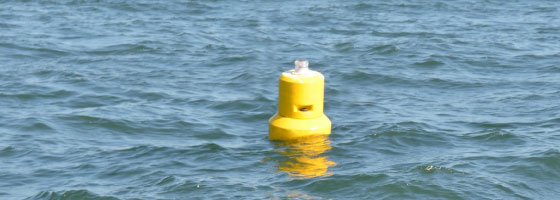Clean beaches, safe water

A new predictive model could change the way beach contamination is monitored.
Imagine spending the day at the beach and learning afterward that you were swimming in water contaminated with high bacteria levels. This nasty surprise is all too plausible in many beaches around the country, including the Great Lakes.
Swimming in contaminated water is probably more unsettling than actually dangerous, but it can make people sick. The Great Lakes support billion-dollar tourism and outdoor recreation industries, so officials are vigilant about monitoring water quality to make sure that the water is safe.
Ensuring the water quality of lakes and beaches is a never-ending task that falls into two categories. Firstly, contamination should be avoided if possible and remedied when it occurs. Secondly, it is critical that beach managers around the country be able to identify when contamination has occurred so that water recreation can be restricted or banned.
Achieving this later goal is surprisingly complicated. Absent seeing contamination happen, the only way to know that it has occurred is to test the water for the presence of bacteria. Scientists generally test for strains of E. coli that are common in animal waste. These non-threatening strains of the bacteria, which also live in human intestines, can indicate the presence of fecal matter in the water. When the number of colony-forming units (CFUs) reaches a federally-determined threshold, the water is no longer considered safe to swim in, said Richard Whitman, research ecologist and station chief of the Lake Michigan Ecological Research Station in Porter, Indiana.
“We call [E. coli] a fecal indicator bacteria… They indicate the presence of waste, and that waste can carry pathogens,” Whitman said.
However, measuring even this relatively straightforward parameter can be difficult. Direct testing of E. coli is expensive and time consuming. Water samples from the relevant lakes and streams must be sent off for testing, which can take 24 hours. By the time a result is returned and the water closed to swimming, people have probably been in it all day.
Even this wouldn’t be such a problem if E. coli levels remained stable over several days. Then, Monday’s result would still be good for Tuesday, and even Wednesday, making closure decisions appropriate. Unfortunately, the Chicago Park District (CPD) has found that their water samples show that E. coli levels are inconsistent – high one day and low the next.
“By the time we posted a ban, the water was OK again, and we didn’t have a ban when the water was bad,” said Cathy Breitenbach, director of Lakefront Operations for the CPD. “Our current system is only correct when high [bacteria] levels last for more than a day.”
A Novel Solution
So how then to measure E. coli in a timely and cost effective manner? The answer: Don’t.
E. coli themselves are an indicator of fecal contamination, not direct evidence. Many factors can cause their presence – migratory birds, other wildlife, and even latent bacteria presence in sand can all cause the tests to spike. The E. coli in the water could themselves be reproducing and driving up the measurements. But there are several environmental factors that have been shown to influence the levels of E. coli in the water.
In collaboration with the United States Geological Survey, the CPD is creating an alternative model to predict E. coli levels by looking at other variables that can be measured instantly. These include wind speed and direction, wave height, turbidity (cloudiness of the water), rainfall, and barometric pressure. All of the above variables fluctuate with E. coli counts, but are much easier to measure. Using an equation that takes into account these statistics, Whitman and his team can estimate the E. coli counts in real time. CPD will continue to take water measurements to confirm the validity of the predictive model. Funding for the project comes from the Great Lakes Restoration Initiative, a federal program managed by the US Environmental Protection Agency that aims to maintain and improve the health of the Great Lakes.
The measurements are obtained by way of buoys deployed at five of the 25 beaches under CPD’s purview. Along with three land-based weather stations, NexSens data loggers attached to the buoys take hourly measurements and use cellular telemetry to publish the data to a website. The data from the buoys and weather stations has also been useful beyond the modeling project. Lifeguards access the data to check the water temperature, Breitenbach said. Beachgoers can also check the water-quality indicators before they head out to a beach where they might not be able to swim. The National Oceanic and Atmospheric Administration has also expressed interest in the data, according to Breitenbach.
“For us [CPD], it’s about protecting water quality, but if I’m taking my kids to the beach, I want to know what the weather’s like,” she said.
So far, the new predictive approach correctly explains approximately 40 to 60 percent of E. coli water test results. While this may seem low, it’s actually about four times as accurate as traditional models. Whitman said highly correlative results are rare in the realm of biological science as there are usually a multitude of uncontrollable factors that can affect results.
“It’s a very complicated and interactive phenomenon that’s going on there,” he said.
Ultimately, the goal is for the predictive model to supplant traditional E. coli monitoring for informing management decisions about restricting swimming, though samples would still be taken to corroborate the model’s results.
One drawback of this approach is that it needs to be adjusted for each unique location.
“Some beaches are very influenced by the architecture of that particular beach,” said Breitenbach, adding that different beaches are also vulnerable to different pollution sources.
However, in the long run, a buoy-based, real-time monitoring system will provide faster results that are less labor intensive than manual sampling. If the predictive model proves its worth, Breitenbach said, it could be put into use next summer.




0 comments